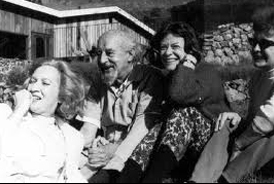by Fritz Perls: Ladies and gentlemen, every one of you is only too aware that we are born into a time of multiple contradictions. Up to the 18th century, a spiritual concept of the world, a religious ideology, was, with very few exceptions, taken for granted. The 19th century saw a break-through of the materialistic approach in science and in the mentality of a great number of individuals. The emotional satisfaction of the religious approach was replaced by the intellectual gratification, by rationalism, predictability and security as far as quantitave calculations could provide. Science scored triumph after triumph by its analytical method, by disintegrating the world into particles and arithmetical figures, but a synthesis hardly went beyond the creation of a league of nations and of chemical ersatz preparations.
The 19th century saw a break-through of the materialistic approach in science and in the mentality of a great number of individuals. The emotional satisfaction of the religious approach was replaced by the intellectual gratification, by rationalism, predictability and security as far as quantitave calculations could provide. Science scored triumph after triumph by its analytical method, by disintegrating the world into particles and arithmetical figures, but a synthesis hardly went beyond the creation of a league of nations and of chemical ersatz preparations.
We suffer, probably more than in any time since the existence of this globe, from doubts and contradictions, from the dualism of mind and body, spirit and matter, theism and materialism. Even the most advanced psychiatric terminology speaks of psychosomatic medicine, as if such things as a soma and a psyche did exist. We have, in general, not yet learned to regard such dualisms as dualities instead of contradictions. No, instead of an integrated mentality, we have an outlook which is a mixture of spiritualism and materialism.
The mechanical age broke with the tradition that the soul is an emanation which entered and left the body with birth and death and at some other rare mystical occasions. Soul and mind now turned into secretions of the brain and ductless glands, and a number of hypotheses, like the association and reflex-arc theory, although contradicting each other, satisfied the mechanically minded. One could cut the brain and the spine into sections and pieces, but one could not integrate them — and one did the same with the so-called psyche.
Three main concepts characterized the mechanistic mentality in regard to psychology, namely:
1. The psyche is identical with consciousness.
2. The mind consists of particles glued together; its functions are dictated by the laws of association.
3. Perception and action are dependent on each other through the neuronic pathways of the reflex arc.
The incorrectness of the first theory has been proved by Freud, and is today accepted by the majority of scientists.
The second theory is slowly being replaced by Gestalt psychology. Even where the Gestalt theory, as such, is not yet accepted, certain aspects of it, especially the idea that the organism has to be considered as a Unity and is reacting with a Unity of purpose, have found a good reception.
The third theory, however, the theory of the reflex arc, has proved of great value for neurology. No wonder that it is so much ingrained in your pattern of thinking that even a slight doubt of its correctness will arouse in you the same hostility and derision which Freud encountered when he first published his revolutionary ideas.
Tonight I cannot embark upon a discussion of this subject, but I wish only to say that I do not believe that the rays of light, for instance, travel in a mechanical way into the brain and incite there a motoric action. I prefer to follow Professor Kurt Goldstein in the assumption that the sensomotoric system should be considered as two systems, namely, as a sensoric system and a motoric system. I personally would like to add that although closely interwoven, these two systems are the organic aspects of orientation and manipulation. Both orientation — or the sensoric apparatus — and manipulation — or the motoric instrument — have the direction from the organism toward the environment, and not one leading into and the other out of the organism. If you visualize the feelers of an insect, or the baby exploring its primary world by mouth, or the blind man’s walking stick or his seeing-eye dog, you get a quick glimpse of the anti-reflex-arc approach. Having thus re-established the sensing into the senses, then philosophy, semantics, theorizing and other means of orientation fall easily into a Unitary concept of the human personality.
The integrative function of the human nervous system finally achieves a specific outlook towards the world, it achieves a Weltanschauung. Such a Weltanschauung is the map or blueprint for our actions. Thus, as long as the concept of the world is a magic one, psychotherapy is executed with magic rites. We see such a practice, for instance, in Christian Science. A moralistic world concept demands the destruction of Evil. The mechanistic orientation will tackle internal conflicts with bromides, mental confusion with the surgical knife. The purely psychologistic schools will attempt to remove complexes and inconsistencies. The sexual economist will restore the functions of the orgasm.
However, in one respect an understanding of many schools of thought seems to emerge, at least in theory — namely the assumption that the neurotic (and I shall confine myself to him) is a split and dissociated personality and that the cure has to be effected by a reintegration of the personality and its intrapersonal relations.
In spite of this hypothetical agreement, its practical following-up is rather restricted as the continual hostility and bickering — or if we speak in the Freudian jargon, the mutual negative transference — shows.
There are several reasons why only in rare exceptions psychotherapists have reached a satisfactory integration which allows them to spot and to eliminate dissociations within themselves and in others; and there are a number of reasons why such an integration of the individual (and of the psycho-therapic movement in general) is difficult to achieve.
There are first of all a number of linguistic difficulties. Notwithstanding the fact that language is the basic tool of the psychotherapists it is in many cases taken for granted that either we use the same words for the same meaning as the persons we deal with, or else, we deem it sufficient to define our meaning, expecting that mere definitions can overcome deeply ingrained patterns of thinking.
If we assume what seems to be the simplest theory — that the modern European and American personality is one which is split into deliberate and spontaneous functions — then we can put down a neurosis as merely being a state of an unsuccessful compromise between these two kinds of functions. Being such a dualistic personality, the modern individual has necessarily also a dualistic mentality and language. He thinks in terms of soma and psyche, of good and bad, of Super-ego and Id, of mind and nature, of Eros and Thanatos, of individual and society. No, we have not yet achieved the tool of a Unitary, of an integrative language. We see dualisms, where there are only dualities or two halves of one-and-the-same-whole, or, in many cases like the human personality, we see objects like the body or the mind or the unconscious where we are dealing merely with different aspects of an organism. We have a body instead of being one, we have a mind or thoughts instead of being this mind or the thinker. You all know that this disowning of one’s properties is especially pronounced in the obsessional character, but it is present in the mentality of all of us, because, after several thousand years of dissociated existence and mentality, we cannot turn the clock back to Heraclitus. We have to forge new linguistic tools adequate to our cultural situation, if we ever can hope to overcome the dissociation of the homo sapiens, if we ever can hope to regain his survival value.
Next to the linguistic, we find a philosophical difficulty, namely the discrepancy between different concepts of integration. Sometimes it is the character which is to be integrated, sometimes the intra-personal relations, sometimes the instincts, and, in most cases, the unconscious and the conscious mind. Often a combination of several aspects is aimed at, but rarely a really comprehensive integration is viewed and planned.
The third point to be mentioned is the sociological question: can we interrupt the vicious circle in which the man of culture finds himself? Can a really integrated personality function in a dissociated society? If we pronounce adjustment to the environment as the aim of psychotherapy and stress the importance of security, can we not expect that the Unitary personality will, as a strange phenomenon, encounter hostility and lose the security which a conformistic attitude would give him? I do not think that we can as yet decide this question. However, the mushroom-like growth of interest in psychiatry at present to be found in the U.S.A., shows the spread of neurosis consciousness and the collective insight that something is wrong in the state of Denmark. Unitary concepts are increasing, and, once people in leading positions, as did General Chisholm, realize that the survival value of mankind is at stake, the vicious circle may be broken. In the meantime we can do nothing other than produce Unitary personalities who are willing to live dangerously and insecurely, but with sincerity and spontaneity.
From what I said before, I hope it has become clear that the unconscious or conscious planning of any treatment is dictated by the weltanschauung of the therapist. Perhaps one can classify two groups, one which interferes with the biological figure background formation, the other which facilitates it. The first one reduces awareness and self-expression, the other promotes it; the one favors deliberateness, the other spontaneity. A man complaining of sexual impotency went to Coue . . . this example is typical of the whole of the first group mentioned. It is in no way different from the method of the physician who prescribes barbiturates for insomnia. The physician does not realize that insomnia is an attempt of the organism to deal with unfinished problems, unexpressed emotions, or other unresolved situations. He prevents the problem in question from coming to the foreground by prescribing sleeping drugs, which are a very potent means of diminishing awareness, and he thus perpetuates a situation which the organism in its infinite wisdom is trying to resolve.
The second group — the one to which you and I belong, will favor the natural f/b formation. For those of you who are conditioned to thinking in terms of an organism made up from a number of particles, like associations, the Gestalt psychological approach may provide a number of difficulties. I should therefore explain in brief the relation of the f/b formation to the systems of orientation and manipulation, to dissociation and psychotherapy.
Let me start with my favorite example. A soldier, on patrol in the desert, after days of struggling and marching under the burning sun, returns to camp. His first word is: water,” or, if he has enough strength left he will, oblivious of anything else, approach the well. An hour later, he will be astonished to find his best friend offended for not having been congratulated on his promotion. Yet our friend had bragged to our soldier about it immediately upon his return.
Our soldier has, during his desert march, lost a certain amount of water — the physiologist would say he is dehydrated — his organismic balance is disturbed, until he has regained a sufficient amount of this fluid. His sensoric tool provides him with a twofold orientation, with an internal — namely the sensation of thirst and the emotion of longing — and with an external one. The world around him becomes irrelevant except for anything related to his thirst. Only a brook or a bottle of beer or something similar jumps into existence, that is: evokes his interest, becomes the figure, the rest a dim background. His friend’s enthusiastic remark did not exist for him, he actually heard it as little as you receive the sounds of a clock of which you were aware, before becoming absorbed in a book. He had receded so much into the background that it did not exist for him. On arrival, our soldier manipulates the world according to his needs; he either walks to the well, thereby eliminating his need by gratification, or he communicates his requirements by gestures or verbalization. After his organismic balance is restored, however, his interest is free for other activities, and his friend’s promotion can become figure, that is, it can become a reality, can jump into existence.
On your camera you have a view finder. This view finder, in contrast to the ancient cumbersome direct observation on a frosted glass, facilitates the taking of pictures considerably. The human organism has a corresponding system at its disposal, it has what we call a mind, or, rather, different strata of minds, of which the sensoro-motoric one is the most primitive. If there is no environment present, which according to the figure/background function can become reality, we visualize, daydream, nightdream, or even archaically hallucinate the situation required for the satisfaction of our needs. It is obvious that such a situation corresponds to Freud’s term of wishful thinking, But the later developed mind systems of semantic appraisal and of higher abstractions provide us with better means of orientation than the senso-motoric mind which is a mere, though often valuable, concrete indicator of our needs. The higher mind system which includes many functions commonly known as thinking, is a combination of orientation and manipulation in minute doses. It selects, rejects, combines, it recalls past experiences, in short, it does what your school has recognized as the function of the dream. It attempts solutions of unfinished situations.
I have called this process an instinct cycle. The instinct cycle shows a cause and a purpose. The cause is the disturbance — for instance, dehydration — which upsets the organismic equilibrium, and the purpose is the regaining of this equilibrium. The links connecting cause and achievement are the figure/background/formation, tensions or drives — in our case thirst — intelligence, efficiency and character. Intelligence is the adequate functioning of the orientative, efficiency that of the motoric system. They together form the pattern of behavior which finally integrates into character and personality.
I have described the working of the organism as if it were essentially spontaneous with little room left for deliberate activity — for instance, planning. It has to be emphasized that at this stage the deliberate activity works harmoniously in the service of the organism, enhancing and not destroying its survival value.
The picture changes with acculturation. Rulers, privileged classes and other social factors introduce tabus and commandments. Moralism ascends the throne. willpower is glorified and deliberate action demanded. But this deliberate activity is essentially a saying “No!”to many instinct cycles, undermining the biological foundation of man, degenerating him and finally bringing about the process which we have the dubious pleasure of witnessing, namely the rapid loss of man’s survival value. This is only too clearly shown by the rapidly rising curves of mental and psychosomatic illness and the spreading insurance mentality — the cry for ever increasing security. With such a somber orientation, what is one to do? Can we arrest or even reverse the vicious circle?
The fact that the U.S.A. is becoming psychiatrically minded, is a hope and a danger. In this state of emergency, analyses of many years duration are a luxury, and brief therapy does not create integrated personalities which alone can guaranty the survival of mankind.
The American government is beginning to plan, so far rather chaotically, an attack on the personality disorders, and as far as education and group therapy are concerned, some valuable work in the mental hygiene field has commenced. But what about the treatment situation?
Like many others, I have tried to find a method to shorten the time required for psychoanalysis, all the time keeping in mind that I must not sacrifice thoroughness, but I may possibly increase its efficiency. My own experiences with the Freudian School, and the many wasted years, had taught me how to avoid many mistakes. But this was not enough. I saw the classical analysis in the light of the first cumbersome and clumsy electrical machine, and saw that one could — to use an Americanism — streamline the psychotherapeutic method. I got much orientation from the Gestalt psychological and semantic trends of thought. Finally I came to a ridiculously simple theory: if the Neurotic is a dissociated personality, one has only to collect all the dissociated parts of the personality and to reintegrate them. On account of its haziness and inconsistency, I had to discard the libido theory; I could not accept its stickiness as cement to glue the dissociated properties together. So I let the death instinct take charge of the libido, turned away from my worship of the gods Eros and Thanatos, and tried to find new bearings. Man is in continuity with nature and therefore obeys the laws of nature. Modern physics has discovered that isolated energies do not exist but are functions of matter. Thus I look for functions and not for energies. I believe I was successful in my search. Integration turned out to be largely a matter of assimilation and contact, aggression a function of manipulation, especially in the service of the alimentary needs. Thoughts, symptoms, memories, habits, were biological processes. With the new outlook I managed to achieve a good deal of integration within myself. From then on the road was easy, for there is a great thing about being an integrated, unitary individual, namely: integration facilitates its own development, just as dissociation arrests or even reverses individual development.
This finding provides us with a clear indication of when to finish psychoanalytical treatment. As soon as the patient has achieved that integration which facilitates its own development we can safely leave him to himself. We can perhaps also use this criterion as a maxim for child education and tentatively say: the child does not want affection, it even hates being suffocated with it. The child wants facilitation, that is, opportunity and assistance for his development.
At this point you probably expect me to elaborate on the ways in which my outlook on the human personality differs from other psychoanalytical concepts. Unfortunately, I must disappoint you. Such a detailed account — beyond what can be gauged from what I have said so far — would take many hours, and I am afraid I have already trespassed sufficiently on your patience. However, I would like to say something about the practical application of these ideas.
Basically, I am applying a push and pull method. I give integration exercises to my patients according to the nature and severity of their dissociation. I know quite well that they cannot do these exercises in an efficient manner, so, as we go along, we analyze the difficulties or resistances step by step.
In this respect to planning, I do not differ much from other psychotherapists. If he is a Freudian and thinks that the neurosis is the outcome of a childhood amnesia, his plan will be to make conscious the whole childhood, and he will set out in his pursuit with his tool of free dissociations, or flight of ideas. Another will search for inconsistencies in the character formation, forgetting the biological substratum and treating the character as something isolated from the organism as a whole, something similar to the religious soul concept. If he is an Adlerian he will systematically pump self-assurance into the patient, raising the level of his confidence. If he believes in external influences he will apply suggestions, if the crux lies with the orgonon he will set free vegetative energies with the perfect orgasm as the goal. If semantic blockages are the scapegoat he will employ the “structural differential” for the cure.
I believe that my concept, in that it considers the organism as a whole is more comprehensive and therefore on the whole more efficient than the methods just mentioned, and except for Reich’s and Korzybski’s approach, more methodical. As my theory assumes that the basic human functions are orientation and manipulation, every interference with the biological instinct cycles will maintain the specific dissociation by diminishing awareness or disturbing the free use of the motoric system. Our patients are desensitized or awkward or both.
The fact that one can achieve results with psychotherapy at all is explained by a very important factor: one often reads about repression of instincts. Such assumption is wrong. Instincts probably can never be repressed. This would result in a changed constitution. What can be repressed is their expression and gratification. The figure/background/formation can be interfered with by deliberately changing one’s attention, recognition of one’s needs by blotting out awareness, for instance, by amnesia, scotomisation, frigidity, semantic blockage, and so on, expression and gratification by linguistic and other motoric blockages, such as paralysis, and, more often, muscular spasms.
To dissolve these pathological interferences, I rely upon the patient’s detailed descriptions of his experiences and my own observation, and try to use as little construction and guesswork — for instance interpretation — as possible, and endeavor to stick to the reality of the analytical situation.
For Freud, the reality principle had the meaning of sensible adjustment to society. Freud, as has been repeatedly pointed out, especially by members of this group, had too rigid a view of society in general and paid insufficient attention to the diversity of the individual environment in particular.
To me reality is actuality. The past exists no more and the future not yet. Both Freud, with his emphasis on causes and on the past, and Adler, with his stress on goal seeking and concern with the future, miss the balance of the present tense.
About a month ago, I had a shocking experience. After years of psychoanalytical treatment, first with a leading, and later with another, analyst of the classical school, a lady came to me in a rather bad state. During her narration she twice jerked as if experiencing an intense fright. Both times it happened when she dared to utter some doubt. I asked her what her analyst had to say about these jerks. Her answer was: “He never noticed them.” However, were I to tackle these analysts about their procedure, they would maintain that of course they start with the present situation. Perhaps they do. If I have one grain of bread for breakfast, I can still say I have eaten something. I may add that she is now quickly recovering from her psychoanalysis.
As the first step towards integrating, I advocate the reawakening of the sense of actuality or reality, the experiencing of the self and the world. The neurotic has a diminished contact with reality. Side by side with avoidance of the company of others, and escape into intellectualism, we frequently find the flight into the past, the looking for so-called causes and explanations and other avoidances of responsibility, or we find the jump into the future, for instance in daydreams or waiting for rewards from heaven — pie in the sky.
A patient of mine spent the first year and a half in treatment telling his analyst about his difficult wife, his disappointing friends, and his business troubles. He dutifully associated to the different people and brought up a lot of material. The actual situation, however, namely the psychoanalytical situation, had a specific significance. As he complained to me about these people, I made him listen to his wailing voice and we discussed the fact that he avoided the tackling of the different people, which would mean personal contact with them, and instead always complained to one person about some other.
I often like to start with a pedantic exercise: I ask the patient to start every sentence with the word “now ” or even “here and now,” as “now I am lying on a couch, now I don’t know what to say, now I feel my heart beating, now I am thinking of the quarrel I had yesterday with my wife.” In the last remarks, the connection between his experiencing a slight anxiety attack and talking about the relation with his wife is obvious. Often, however, the patient will escape from experiencing the present. He will go into the past or the future, especially if he has had a drill in the Freudian or Adlerian method respectively. I maintain that the past is of significance only as far as it embodies unfinished situations — for instance — undigested experiences. The futuristic thinking also becomes pathological if, instead of being aware of the present deficiencies, the patient drugs himself with “if’s” and other forms of daydreams. We always dream in the present tense, we experience a dream as an actuality. The knowledge of this phenomenon is often applied in hypnosis by making the patient go back, as if traveling in a Wellsian time engine, to the place and time of the past. Such a procedure can be used without any hypnotical complications. Try it on yourself. Go back to any place of your childhood and simply describe in great detail what you actually visualize. You will be astonished what a lot of forgotten material you will recover.
After the patient has grasped the concept of the “now,” I usually drop the word “now” and acquaint him with my formulation of the basic rule which says that he should convey to me everything he does and experiences intellectually, emotionally and physically, that he should neither hold back anything deliberately, nor force himself to say something that he dislikes expressing. He should indicate only that there is something he does not want to or cannot reveal.
As you recognize, the last part of the basic rule allows for the dealing with the censor and the discussion of the different forms of emotional resistances, like embarrassment, fear, disgust, politeness, and so on.
The first part of the rule is, as far as I can see, comprehensive, especially if you bear in mind that thinking is orientation and manipulation in minute doses, that thinking is invisible action. At that stage, the phenomenon of running away into the past or future with the loss of reference to the present, serves as a good indication of the extent to which the patient is willing or capable of co-operating. The general pattern of his interpersonal relationship is also coming readily into the analytical situation. He will be slavishly obedient, or making fun of the procedure, he will be cooperative on the surface but leading the rule ad absurdum, he will talk about the rule instead of complying with it. However, after he has had experiences which shake him to the core, then his not complying always indicates considerable resistance which he slowly learns to recognize.
I shall briefly relate two cases demonstrating extremes in cooperation.
One is a woman of about 40, a social worker with the ambition to become a psychoanalyst. She talks a highfalutin language with technical terms replacing content. She is a coarse type, but suffers from the delusion that she is a lady, born for higher purposes in life. For a long time I could do nothing except persistently try to persuade her to attempt the basic exercise. She would insist that this was a waste of time, or she would be bored, or enumerate the contents of the room. She did not feel anything beyond an occasional heart beating. She was,in other words, deeply desensitized and intellectualized, if you can call her dementia verbosa intellect. One day, however, it was the 14th hour with me, she came in with a notebook in which she had mapped out prescriptions of how I should conduct the analysis. When she lay on the couch, she always lay in a closed position, but that day she opened up a bit, and after a time became very restless and even became aware of this. Finally she burst into tears and said: “I feel like a ship which is tossed about by everybody. I must keep my superiority, otherwise I am lost.” This first breakthrough took 14 hours — however, as a breakthrough it did not amount to anything. On the contrary, she even became more difficult and was on the verge of giving up. As I am not in the habit of blaming a patient and making her responsible for her resistances, I had to look for my own deficiency, and I found the following facts: I was personally involved in her case. She had to be a feather in my cap, she was a test of whether or not I was capable of handling such difficult cases. That means that I had lost the analytical objectivity and had made her a tool of my ambition. Instead of dealing with the present only, I had become involved in futuristic or purposive thinking. I further noticed this: when she produced her suggestions, I had felt angry, that this pipsqueak wanted to tell me how to go about my business. This anger was an indication that somehow she must be right. She could and did teach me something: namely, that I had slipped up on my own theory, that instead of looking at the actuality of her symptom, of her need for being top dog, I had reacted to it.
Then I let her live through her needs for making suggestions, demands on people. This finally crystallized in the demand of being accepted under any condition. I then explained to her that she wanted to be accepted, but that she was not willing to accept me and my way of dealing with her, what’s more — that she was not willing to accept her own emotions. She is now beginning to show insight into her neurotic conflict, into her struggle between the artificial facade and the emotional self which she fears.
The contrasting case has had five hours so far. He is a philosophy student who was said to be schizoid. He came to analysis because life had lost its flavor, he could not concentrate any more, and he had thoughts of suicide. He is homosexual, but is no longer practicing it. Philosophically, he was interested in the Aristotelian approach, but lately he has become interested in Husserl and somewhat in the French school of existentialism.
As my approach is somewhat similar to Husserl’s phenomenology, he had no difficulty in grasping the meaning of my approach, and after the first half hour I could introduce the next step — the dealing with processes. Whilst in the beginning it is sufficient for the patient to realize that something quote “is” unquote, there, later he must realize that something is going on, or rather on and on and on. He has to get acquainted with the fact that his experiences, his behavior, his symptoms, his thoughts, and so on, are processes or time-space events. They have duration. He has to learn to concentrate on his symptom, to follow up the development that takes place when he is in contact with the symptom, when he is resensitizing and remobilizing it.
Here is a part of the third hour. He relates: “The front of my head is aching, my mouth is dry, my head wants to push back into the pillow. Now I am breathless. I see myself running down the street. A motor car is running over me, but does not touch me. I don’t know whether this really happened. My knees are very heavy, my eyes want to close, I feel as if I want to cry, but can’t. I have not cried for six years.” Then he starts talking about hi’s father who was run over by a motor car and killed. He relates this and the details of the accident and death in a matter of fact voice. The moment, however, he visualizes the coffin, he bursts into a loud, intense, and genuine crying.
The same patient has a syndrome which one can best tackle by home exercises. These home exercises are an important factor in the shortening of the treatment. Although the classical analysis demands that the patient should only submit himself to the analysis and that he should stop doing things, the Freudian analyst will welcome the patient’s finding out something about himself or, in a case of agoraphobia, his making attempts to cross the street. So why not plan and organize the co-operation of the patient, or, in case of unconscious sabotage or compulsive dummy activity, use this for the mobilization of his resistance awareness?
Our philosophy student has lost his contact with and the liking of his environment. As far as I can see this always goes hand in hand with a dead palate. He does not enjoy or taste his food. He enjoys eating only when he has cooked something for another person and the other likes it. In a case like this I give eating exercises, starting with observations of the amount of attention the patient gives to his eating. Is he reading or day-dreaming during the meal? Does he gulp his food down, in other words, drink even solid food?
After the fifth session, he has already begun to taste his food and correspondingly life starts to become interesting again. He begins to go about and resumes contact with friends. Although on the whole, he is still very wooden in his speech, some loosening up of his emotional life such as a slight smile, can already be seen.
If a patient has desensitized his visualization and has, instead of pictures, only words in his mind, I try to develop his interest in noticing his environment instead of merely abstracting from it. At the same time, I aim at dissolving the reluctance to face the world and form an impression of it.
The female patient mentioned before has a complete blockage in regard to visualization. At present there is no question yet of embarking on .such tasks, as she is interested only in how the world looks at her.
A very intelligent and conscientious instructor came for analysis for his sexual impotence. Fie took quickly to the concentration technique. After very few sessions he wriggled on the couch in a peculiar way which he recognized as a struggle he had had with his mother, when at the age of 9, she forced him to lie still while she removed some worms or something from his genitals. In the following sessions his movements changed and we followed them up with interpretations. However, the fact that he interpreted so easily, and that he was well acquainted with Reich’s work, made me suspicious. Perhaps he was living up to his expectation of Reichian analysis. I also was not willing to give up so quickly my opinion about the decisive importance of the actuality situation. Finally he produced a symptom of restlessness which did not cease and which for the first time he himself could not interpret. He could not settle down on the coach, He kept one or even two shoulders away from the cover. This looked to me like a wrestling position. He confirmed this impression. He remembered a fight where he had resisted similarly. The symptom, or rather, his body language persisted, until I asked him if by any chance this symbolized his attitude towards me. And then he let go. We had had an argument some time before about experimental psychology, and he’d been damned if he would submit to my viewpoint. After my question: “Could we not agree to disagree?” he calmed down and for the first time settled down comfortably.
In the majority of patients, the direct attack on the desensitization and immobilization, provides no difficulty. On the contrary, the patients realize soon that something is going on; they see painful and uncomfortable symptoms disappear or rather change into a feeling of well being. In all these cases a certain contact with the self had survived in spite of rigid self control.
However, at least three types require the prolonged spadework of intense character analysis before one can attempt the phenomenological analysis. In these types, one finds a deep seated contempt for their spontaneous personalities, a rejection of “what is” and a glorification of “what should be.” These people hanker after ideals. They have alienated their own feelings and needs to such an extent, that under no circumstances must they recognize and still less accept their selves.
Besides the one type mentioned earlier, there is the “as if” personality — to use a term coined by Helene Deutsch. Patients of this type assume roles and will with pseudo-compliance deceive the analyst just as they bluff their way through life in general. Not before they realize the fact that they are always on stage, that they have not a character armor, but a wardrobe full of costumes will they come out with their true nature. This step is usually accompanied by a feeling of great emptiness and sensation seeking. There is one symptom which often heralds the existence of an “as if” personality — chronic boredom. As you probably know, boredom sets in when your attention is deliberately given to a situation in which you are not interested, and when, at the same time, the natural figure/background/formation is blocked. The “as if” personality, instead of giving in to the f/b/f, tries to overcome boredom by ever-increasing addiction to thrills and sometimes to drugs.
Another type that provides great initial difficulty is one of the obsessional types. I am not referring to the conscientious, systematizing, perhaps over-systematizing hard-working type. He is highly cooperative. But there is another obsessional character who is mostly conscious of a fear of being made a fool of. He indulges in unconstructive dummy activities in his mind, as well as in his life. He is always serious, but never sincere. With him, the initial difficulty lies in making him aware of the fact that he has one aim — to gather secret triumphs. He will lead your demands ad absurdum, argue for hours, frustrate you and demonstrate that you are an impotent ass, incapable of dealing with such a clever chap as he is. But he has projected his fooling, and imagines that other people want to make a fool out of him. He fails to realize that he is the one who is out to fool everybody. Only after he can realize what a fool he is to spend his life with fooling about will he settle down to sincere work and cooperation.
Perhaps one can also include in this category a type that is often distinguished by its valuable contribution to society. This is the person who always has to justify his existence. You know that a man who has to prove his sexual potency is not very sure about it. You find a similar structure in the person who feels the need of justifying his existence. He does not exist fully. He is, like the other three types enumerated before, desensitized to such a degree that intellectual and social goals have to replace the unfelt biological drives. Without his constructed aims he would feel as empty as the other types. Marx once said that the existence of a phenomenon proves its requirements. Without the American neurosis, psychoanalysis would quickly die in the States. Similarly the French philosophical movement of existentialism derives its raison d’etre from our rapidly dwindling self-awareness.
Alcoholism presents a very interesting contribution to our theme. It is a futile attempt to solve the conflict between self-expression and desensitization. Drinking assists in the emotional discharge — thus lowering unbearable tensions, but the conscience or ideal, as well as the feeling of unworthiness and self-consciousness, are desensitized only temporarily. The alcoholic, like other neurotics, has failed to surrender his individuality to society, he has not adjusted himself to society’s demand that he become a well-behaved robot.
I must finish. I cannot go into the details of all the different forms of dimming orientation and manipulation. I have to omit the very interesting connection between the numbness of the alimentary functions and the paranoid phenomenon, between retroflection and repression, between Ego development and contact function, and many other occurrences dealing with awareness disturbances, but I can roughly sketch the course which the average treatment takes:
In the forefield we find the character as a safeguard of the status quo. After working through the main characterological resistance, the patient learns to experience himself again. The main point in this experiencing himself is the optimum of awareness, the discrimination between pathological introspection and intensified existence. Through experiencing his personal processes, he is becoming aware of his split into deliberate, suppressive and a spontaneous, suppressed personality. During this time he identifies with the suppressing part, which tries to dissociate itself by all means, for instance by muscular contractions, from the unacceptable part of his personality. At that stage his interpersonal relations are colored by his fears of not being acceptable to his environment. In the next stage, his self-control, self-reproaches, self-punishment, has to be redirected towards the environment, thus multiplying his contact possibility with his enemies and friends. Deliberately he begins to control, reproach, punish, them. This redirecting enables him to finish many conflicts which, by internalization, had become permanent. He changes self reproach into object approach. By identifying with all his processes, he is slowly learning to accept his spontaneous personality. With the disappearance of his internal conflicts, he becomes sufficiently strong and unified to regard his opinions as of equal importance as those of others. Instead of living in continuous fear of being rejected, and need to be accepted, he is now doing the accepting and rejecting. He takes just as much from the world as he is willing and capable of assimilating for his future development. Whilst in the pre-treatment period he had accepted and rejected people for being good or bad, he discriminates now situations and properties, he develops a taste of his own and manipulates the world toward an optimum of collective satisfaction. Deliberateness changes from authoritarian self-control into liberal self-and object-management.
I hope that I was able to show that neurosis is an unbiological attempt of solving man’s social problems. It acts in the pattern of the biblical “If an eye offends thee tear it out.” The result is a limited instead of a wholesome personality.
The reintegration of the dissociated parts of the personality is best undertaken by resensitizing and remobilizing the system of orientation and manipulation. As far as I can see, this program is comprehensive. By experiencing his symptoms, etcetera, as processes, the patient acquires the awareness and conscious control required for his semantic and social adjustment — that is, the understanding of his personal needs and the manipulation of his environment. These processes are actually taking place and must therefore be dealt with in the present as the balancing point between past and future. The reorganizing of the personality consists of both disintegrating and integrating processes, and should be balanced so that only such amount of dissociated material should be set free as the patient is capable of assimilating. Otherwise his social or even biological function may
be dangerously upset.
The analytical disintegrative process concerns infantile and irrational orientation, uneconomical and rigid manipulation, emotional and semantic blockages. The integrative processes are the recognizing and assimilating of traumatic, introjected and projected material, the functions of contact and emotionally and semantically adequate self-expression.
As soon as the structure of the neurosis is clear to the therapist, he should plan his course of action, but remain alert and elastic during the whole treatment.
I do not want to conclude this paper without mentioning one point of danger: between the one-sided approaches, namely, between the purely psychologistic concept of Korzybski, Adler, and Horney, and the biologistic method of the schools of F. M. Alexander and Elsa Gindler; between the analytical technique of Freud, and the creative endeavor of, say, a music teacher; between Reich’s sexualized personality and Jung’s desexualized libido. In the midst of all these abstractions of the complete personality, there is enough room, even the need, left, for these and many more forms of operation. The other danger involved is eclecticism. Instead of having a comprehensive and Unitary point of view and operation right in the center, one might jump from one method to another and back again, spreading confusion and producing merely a different type of dissociated personality.
The safeguard against such a danger is the concept and experience of the human personality as being an indivisible whole and as always embedded in, and related to an environmental personal and social field. As your society starts just from this, assumption, the danger of succumbing to such eclecticism is slight. On the contrary, if I may make a suggestion, I recommend as necessary complementary aspects of the study of the human personality at least three subjects: Gestalt psychology, semantics, and last but not least the approach of the Gindler School.
Finally I would like to make some personal remarks: I wish to express my gratitude to you for having given me the opportunity to voice my point of view.
After many years of struggling on my own in Africa with the Freudian ideas, I came to some conclusions. Although Freud was the Livingstone of the Unconscious, the map which he had drawn had already become antiquated. It did not represent any more a true means of guidance, it had to be redrawn. I believed I had found some relevant points of orientation, but many blanks — for instance, what constitutes awareness — were still left. So I had come to a place where my drawing could be checked and where I could possibly get some of the blanks filled. As the point of gravity of science has shifted to the U.S.A., your country was the obvious goal. In South Africa, I was considered a megalomaniac rebel for daring to contradict the words of the master; in Canada, a fool for doubting the sacrosanct reflex arc; in New Haven, a stray dog for wanting to do psychotherapy without a medical license, and, what’s more, without belonging to an established group; in New York a plain lunatic for having abandoned a secure economical position. Something had to be wrong with me, or I had to have an ulterior motive. Of course, I understand, I cannot attack the roots of a man’s credo and, at the same time expect to be accepted, but I knew that I was not merely destructive, but constructive and instructive as well. Was I so completely mistaken or were all of them blind? Then a miracle happened to me. A few months ago I met some members of your group, and I was deeply moved as I had been seldom in my life. After all, there were people on this globe who saw the world as I saw it, who spoke a language similar to mine. It was like a dream, nearly too good to be true. I felt like a sailor who knew he was steering the right course, but became weary that he would never see land again, and suddenly, unexpectedly, there it was. But this was not all, this must not be all. The great tide of man’s disintegration, of mankind’s suicide is coming in. Dykes have to be built. Could we do it together? Could the hope that it may not be too late, turn into possibility?
Freud started with the neurotic as an exceptional case amidst a healthy environment. I believe, however, that neurosis has become an all embracing social phenomenon. Thus the question I have to put before you is: Is the time ripe to attack this social illness on a scale different from our present piecemeal approach? Can or should one plan psychotherapy on a grand scale? I personally doubt that society and administration are ready to see the severity of the problem, but I have the impression that they are no more completely desensitized to the existence of the problem itself.
Freud saw only the discomfort in our culture. Spengler visualized the doom of the Occident. We witness just now the disintegration of Europe, but we witness something else as well. Previously, one culture could finish its cycle and disappear, and there was enough room on this globe for many more to come. But the world has shrunk, every nation is drawn into the orbit of the European-American culture cycle. Thus the end of this culture means the end of everything. A schizophrenic weltuntergangs phantasy, the phantasy of the world’s doom, seems to become a reality.
“It was not a scientist, but a poet, who has seen this first. It was D. H. Lawrence who said:
… Connie laughed. The rain was pouring down.
‘He hated them!’
‘No,’ said he. ‘He didn’t bother. He just disliked them. There’s a difference. Because,’ as he said, ‘the Tommies are getting just as priggish and narrow-gutted. It’s the fate of mankind to go that way.'”








































